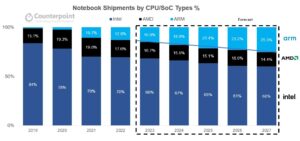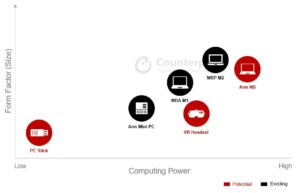- Arm-based notebooks will gain share over Intel and AMD, almost doubling their shipment share to 25% by 2027 from 14% today.
- Featuring high-performance CPU cores and integrated memory, Arm-based PC SoCs are poised to rival x86 CPUs, with advanced AI and GPUs providing capabilities that surpass those of traditional x86 PCs.
- Arm-based PCs consolidate several components into smaller devices, facilitating the integration of laptop and tablet form factors while offering a variety of form factors such as stick and VR headsets.
Personal computers (PCs) based on Arm architecture will grow in popularity and their market share will almost double from 14% now to 25% by 2027, according to Counterpoint Research’s latest projections. The ability of Arm-based hardware to run Mac OS has allowed Apple to capture 90% of the Arm-based notebook computer market. However, the full support of Windows and Office365 and the speed of native Arm-based app adoption are also critical factors in determining the Arm SoC penetration rate in PCs. Once these factors are addressed, Arm-based PCs will become a viable option for both daily users and businesses.
As more existing PC OEMs/ODMs and smartphone manufacturers enter the market, they will bring their expertise in Arm-based hardware and software, which will further boost the popularity of Arm-based PCs. The availability of more native Arm-based apps will also increase user comfort and familiarity with the platform. Overall, the trend towards Arm-based PCs is expected to continue and their market share will likely increase significantly in the coming years.
Notebook Shipment Share by CPU/SoC Type

Source: Counterpoint Global PC Forecast, Q4 2022
Arm-based PC SoCs to compete with x86 CPUs
- Arm-based PC SoCs are highly customizable. Unlike x86 CPUs, which are designed to be general-purpose processors, Arm-based SoCs can be tailored to specific use cases. This means that SoCs can be designed with a greater number of high-performance CPU cores and highly integrated memory, enabling them to compete with x86 CPUs. Their custom cores can enable more advanced features that are not possible with off-the-shelf processor cores, and allow for better integration with hardware and the operating system. Furthermore, Arm-based SoCs can incorporate highly integrated memory, resulting in faster and more efficient memory access. This can lead to improved performance in graphics-intensive tasks by enabling faster data access and sharing between the CPU and GPU.
- Arm-based SoCs offer several advantages over x86 CPUs, including lower power consumption and improved thermal efficiency. Additionally, their integrated AI-feature cores make them superior to x86 CPUs. They are designed with power efficiency in mind and can be customized to meet specific power requirements. This makes them ideal for use in mobile devices and laptops, where battery life is crucial. With the increasing demand for AI capabilities, there is a growing need to enhance various multimedia tasks, such as image and video encoding and compression, noise cancellation, vocal enhancement, and style transfer. By integrating AI technology into Arm-based notebooks, these tasks can be performed more efficiently, resulting in improved performance and user experience. Moreover, the integration of GPUs can further enhance the device’s overall performance by accelerating computational tasks such as machine learning and image recognition. This allows for faster and more accurate results, making it possible to run more advanced applications and software on Arm-based devices.
Arm-based PCs integrate more components into compact devices, allow multiple form factors
- The size and weight of PCs are expected to decrease with the introduction of Arm-based SoCs. This will result in a smaller size difference between Arm-based PCs and tablets, facilitating easier integration of these two form factors by manufacturers. This is likely to lead to an increase in the production of laptop-tablet hybrids that can seamlessly switch between the two modes. With the growing popularity and affordability of these devices, convergence between laptop and tablet form factors is likely to intensify.
Arm-based PC Potential Applications

Source: Counterpoint Research, Q1 2023
- ‘Windows on a Stick’ or ‘Windows To Go’ is a portable version of Windows that runs from a USB flash drive and can be used on any compatible x86 PC. Small form-factor devices like this face hardware resource limitations, but Arm-based SoCs offer better performance and integration. This makes them especially useful for small devices like the OS on Stick, providing better performance and more efficient use of space.
- The SoCs being used in VR headsets currently are typically based on smartphone-grade processors, which are designed to balance performance and power efficiency for use in mobile devices. While these SoCs can provide good performance for VR applications, they may not be able to match the performance of high-end PC-based processors in more demanding use cases. However, if Arm-based PC-grade SoCs were used in VR headsets instead, they could allow VR headsets to provide PC-like performance, with the ability to handle more complex and demanding VR applications. In addition to the improved performance, using Arm-based PC-grade SoCs in VR headsets could also enable the use of PC-like applications and provide users with access to a wider range of software and applications, as well as more familiar user interfaces and tools.
Conclusion
Arm-based PC SoCs offer several advantages over x86 CPUs, including customizability, lower power consumption, and integrated AI and GPUs. The rise of Arm-based PCs is expected to continue with the support of Windows and Office365, native apps, and industry experts. This trend is likely to lead to the integration of laptop and tablet form factors and the use of Arm-based SoCs in small devices and VR headsets.
Related Blogs/PRs:
- PlayStation VR2 Review: Great Experience But Tough Competition in Store, MARCH 16, 2023, BY BRADY WANG
- Arm Laptops to Remain Resilient Amid Global PC Market Weakness, FEBRUARY 8, 2023, BY WILLIAM LI
- Global PC Shipments See Record YoY Decline in Q4 2022, JANUARY 19, 2023, BY WILLIAM LI
- VR Headset See-through Tech to Help in MR Development, DECEMBER 20, 2022, BY BRADY WANG
- Global PC Shipments’ Double-digit Crash in Q3, OCTOBER 25, 2022, BY WILLIAM LI
- M1 Pro, M1 Max Give Definitive Push to Apple’s M1 Journey, OCTOBER 25, 2021, BY BRADY WANG
Related Reports:
- Global Quarterly Arm PC forecast Q4 2022, Mar 9, 2023, Author : WILLIAM LI
- Global Quarterly Arm PC tracker Q4 2022, Mar 9, 2023, Author : WILLIAM LI
- Apple M1 Macs Review, May 6, 2021, Author : BRADY WANG

